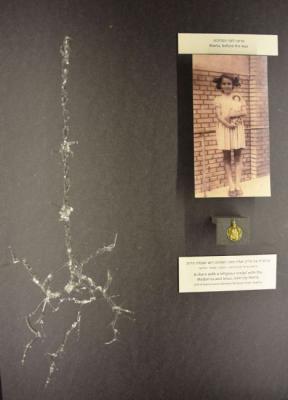12 April 2015
Of the six million Jews murdered in Holocaust the were approximately one-and-a-half million children. Only relatively few survived, against all the odds.
On 12 April 2015, "Stars Without a Heaven: Children in the Holocaust," opened at Yad Vashem. The new exhibition presents a collection of anecdotes, narratives and memories of Jewish children caught up in the crucible of the Holocaust. On exhibition are items from Yad Vashem's Artifacts, Art and Archives Collections, enhanced by films made about children, artworks created by their relatives, music composed to accompany lyrics written by them during the Holocaust, and more. In addition, students from the Bezalel Academy of Art and Design, Jerusalem, and the Holon Institute of Technology-HIT created works of art from ceramics, porcelain and glass, as well as animation, in order to enrich the visual representation of the lives of children during the Shoah.
The exhibition is designed as a symbolic "forest" structured around eight major themes: play, learning, friendship, identity, work, home, family and rites of passage. Each one of the 33 "trees" contains a main story, with additional stories played on digital screens. A few trees present more general themes such as orphanages and youth groups.
One of the trees is dedicated to the story of Martha Goren, who as a young girl was given refuge by a Polish family and their housekeeper. Martha took on her new "Polish" identity so well that at the end of the war, it was extremely difficult for her to leave her adopted family and Christian customs behind. Exhibited in the "tree" are a few childhood photographs of Martha, a copy of the religious icon she wore around her neck during her time in hiding, the certificates bestowing the title of Righteous Among the Nations upon her rescuers and part of a filmed testimony she gave at Yad Vashem. Also on display is a delicate glass sculpture depicting her struggle with her religious identity, and two animated films illustrating the emotional turmoil she experienced in parting both from her biological mother and from her adopted mother. "I am so moved that you have found a way to commemorate my family within this exhibition," said Martha at a pre-opening visit. "I don't think my mother could have ever imagined that I would survive, that I would come to Israel and I would manage without her - that I would have a husband, and children, grandchildren and great-grandchildren. It is so difficult for people who weren't there to imagine what it was like, but this exhibition will help both adults and young people connect to the emotional world of the children during the Shoah."
"Martha's story represents so many other children who are unable tell what happened to them," says Exhibition Curator Yehudit Inbar. "She also embodies the positive energy so many of these innocent minors emitted in a world turned upside-down. Martha is a shining example to us all of how, with the right combination of chance, as well as assistance and optimism, it is possible to raise oneself from the lowest depths and make one's life - and the world - a better place."
The exhibition was made possible by the generosity of the Warren family, children, grandchildren and great-grandchildren in honor of Nomi Warren (USA), survivor of Auschwitz, Ravensbruck and Bergen Belsen; and through the generosity of Yvette Graubart Blaiberg (Belgium); The Paul & Pearl Caslow Foundation, Esther and David Mann and Betty Breslaw (USA); and Carter's Inc. in honor of Avraham Bondi Livnat (USA).
For more on the exhibition, please see Yad Vashem Jerusalem Magazine, vol. 77 (May 2015).





.jpg?itok=To3JRcm3)


